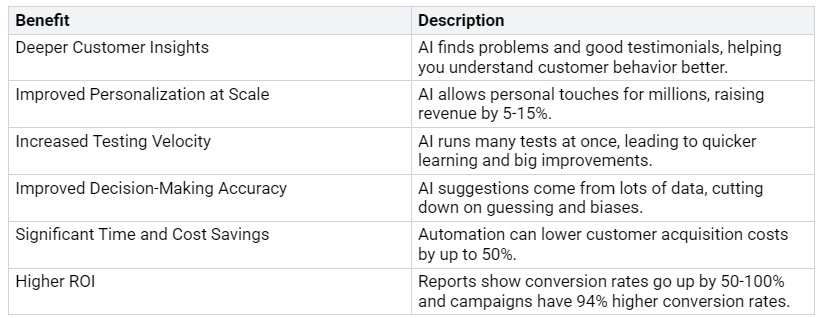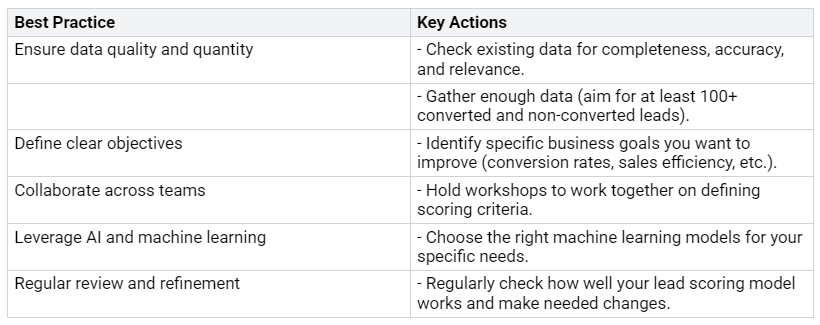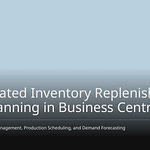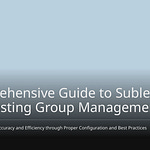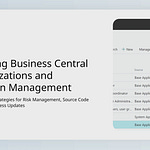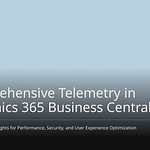Predictive lead scoring is very important in sales today. It helps you find which leads are likely to buy. This saves time for your sales team. Old methods use fixed data, but AI makes lead scoring better. It looks at a lot of information. This includes structured data, like company size, and unstructured data, like customer talks. By using AI, you can make your sales work better and faster. For example, companies that use AI lead scoring have seen a 77% rise in lead generation ROI. They also report a 10-15% increase in sales revenue.
Key Takeaways
Predictive lead scoring finds leads that will buy. This saves time for sales teams.
AI makes lead scoring better. It looks at both organized and unorganized data. This leads to more accuracy.
To use AI predictive lead scoring, you need clear goals, good data, and teamwork.
AI-driven sales optimization can raise conversion rates by 25%. It can also shorten sales cycles by 30%.
Review and change your lead scoring rules often. This keeps them effective and in line with market changes.
Predictive Lead Scoring Overview
How Predictive Lead Scoring Works
Predictive lead scoring is a strong method. It helps sales and marketing teams rank potential buyers. This ranking shows how likely they are to buy. The method gives scores to leads. These scores show their value to your company. According to top sales tech sources, “Predictive Lead Scoring is a technique used by sales and marketing teams to rank prospects against a scale that represents the perceived value each lead represents to the organization.“ This system looks at many actions. These include website visits, email opens, and social media posts.
Old lead scoring models often do not work well. They depend on set rules and personal guesses. Here are some main differences between old and predictive lead scoring:
Old lead scoring uses set rules and personal guesses.
Predictive lead scoring uses machine learning to study big data and find key signs of lead quality.
Old lead scoring is done by hand and needs deep thinking and analysis.
Predictive lead scoring automates data study. It finds ideal customer types and traits for success.
Predictive lead scoring looks at past data to see who bought and why. It gives scores to new leads based on real patterns, not guesses.
Old models also have many problems. They often focus too much on behavior data and ignore demographic info. This can make it hard to find good leads. The lead scoring process can take a lot of time. This makes it hard for sales reps to check leads quickly. Many models are too simple. They use basic metrics that do not show the details of each lead. Also, companies may not want to change their scoring rules. This can lead to wrongly classifying leads. Lastly, old or unbalanced data can create low-quality scoring models. These models do not show current market conditions.
By knowing these points, you can see why using a predictive lead scoring system is important. It can improve your sales strategy.
AI Lead Scoring and Data Utilization
AI lead scoring changes how you look at data. It helps you find valuable prospects. It uses both organized and unorganized data to give a full picture of potential leads.
Types of Data for AI Lead Scoring
Structured Data: This data is organized and fits into tables. Here are some useful types of structured data for AI lead scoring:
Unstructured Data: AI is also good at handling unstructured data. This includes emails, social media chats, and other text. Here’s how AI works with this data:
AI uses Natural Language Processing (NLP) to study text from emails and social media. It breaks down the meaning and finds important themes.
Sentiment analysis checks customer feelings. This is key for knowing lead quality.
Machine learning finds patterns and guesses future actions. This makes lead scoring better.
Engagement signals are very important in AI lead scoring. These signals, like website visits and email opens, show a lead’s interest. AI systems use these signals to look at past actions. They find patterns that link to successful sales. Studying behavior data makes lead scoring more accurate. It shows how involved a lead is with your brand.
By combining both structured and unstructured data, AI lead scoring builds flexible scoring models. These models change with the market. This helps you focus on leads that really want to buy. It improves your sales predictions and overall efficiency.
Benefits of AI-Driven Sales Optimization
How AI Helps Optimize Sales Strategies
AI-driven sales optimization makes your sales strategies much better. You can see higher conversion rates and faster sales cycles. With AI, you learn more about how customers act. This helps you find problems and good testimonials. Because of this, you can make your approach more personal. This can lead to a revenue increase of 5-15%.
Here are some clear benefits of AI-driven sales optimization:
AI systems keep learning from new data. This ongoing learning makes them more accurate and effective. You can expect better lead response times, conversion rates, and shorter sales cycles. Studies show that companies using AI see a 10-15% drop in sales cycle length. For example, a Fortune 500 company cut its cycle from 6-9 months to just 3-6 weeks.
Also, AI-driven sales optimization improves forecasting and pipeline management. It automates boring tasks, letting your sales team focus on important work. AI tools make workflows smoother, boosting overall productivity. By automating admin tasks, your sales reps can spend more time talking to prospects and closing deals.
Implementing AI Predictive Lead Scoring
Using AI predictive lead scoring can really improve your sales process. But, you might face some problems while making this change. Here’s how to make the implementation go smoothly.
Overcoming Implementation Challenges
To successfully use AI predictive lead scoring, follow these important steps:
Map Your Current Sales Process: Find out where AI lead scoring can fit into your current workflow. This helps make the integration easier.
Establish Clear Objectives: Decide what you want to achieve with predictive lead scoring. Set clear goals, like improving conversion rates or making the sales cycle shorter.
Ensure Data Quality and Quantity: Check your current data for accuracy and completeness. Aim for a strong dataset, ideally with over 100 leads that converted and did not convert.
Configure Your CRM: Connect your Customer Relationship Management (CRM) system with the AI lead scoring tool. This keeps lead scores updated in real-time.
Automate Workflows: Use tools like Marketo or Pardot to make lead routing and follow-up tasks easier.
Communicate Benefits: Share the benefits of AI lead scoring with everyone involved. This includes sales teams, marketing teams, and executives.
Provide Ongoing Support and Training: Answer any questions or concerns that come up during the rollout. Continuous training helps your team get used to the new system.
Monitor and Adjust: Regularly check how well your AI lead scoring system is working. Get feedback from your sales team to find areas that need improvement.
Remember, successful implementation needs teamwork across all groups. Hold workshops to set scoring rules and create shared terms for lead qualification.
Even with the benefits, you might face common challenges during implementation:
Not Enough Data: Not having enough data can hurt how well predictive models work, especially at first.
Inconsistent or Missing Data: Even with lots of data, inconsistencies can lower lead scoring accuracy. Make sure marketing and sales teams are aligned.
Setting Up the Right Qualification Criteria: It’s very important to define lead scoring criteria correctly. Keep checking and adjusting these criteria to avoid treating the model like a ‘black box’.
Sales Teams Not On Board: Teaching your sales team about the predictive model is very important. Without their support, they might go back to old lead conversion methods.
To make sure your implementation is successful, think about these best practices:
By following these steps and best practices, you can effectively use AI predictive lead scoring. This will help you find and prioritize leads, making your sales pipeline better and increasing the chances of conversion.
In short, using predictive lead scoring and AI for sales can really boost your sales results. With AI, you can handle a lot of data. This helps you focus on the most important leads. It also gives you scores in real-time. This way, you can contact leads when they are most likely to buy.
Here are some benefits:
AI can raise conversion rates by up to 25%.
You might see a 30% cut in sales cycles.
AI helps find high-quality leads better.
As you look into these methods, make sure to focus on data quality and give thorough training to your teams. Using these new ideas can change your sales process and help your business grow.
FAQ
What is predictive lead scoring?
Predictive lead scoring ranks leads by how likely they are to buy. It uses data analysis to find customers with high potential. This helps you focus on the leads that matter the most.
How does AI improve lead scoring?
AI makes lead scoring better by looking at both organized and unorganized data. It finds patterns in how customers act and engage. This helps predict which leads are likely to buy more accurately.
What types of data do I need for effective lead scoring?
You need both organized and unorganized data. Organized data includes company details and buying signals. Unorganized data includes emails and social media chats. Together, they give a full picture of potential customers.
How can I measure the success of predictive lead scoring?
You can measure success by looking at conversion rates and how long sales take. Check how many leads buy after using predictive scoring. Also, see if your sales cycle gets shorter because of it.
What challenges might I face when implementing AI lead scoring?
Common challenges include problems with data quality and getting team support. Make sure your data is correct and complete. Also, explain the benefits of AI lead scoring to your sales and marketing teams.



